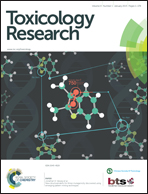Specific histone modifications regulate the expression of AhR in 16HBE cells exposed to benzo(a)pyrene†
Abstract
An aryl hydrocarbon receptor (AhR) is a transcription factor mediating the responses to polycyclic aromatic hydrocarbon (PAH) compounds. To investigate the epigenetic mechanism involved in the regulation of AhR, we treated human bronchial epithelial cells (16HBE) with benzo(a)pyrene (BaP) and found a transcriptional suppression of AhR in a dose- and time-dependent manner. Suppression of AhR significantly attenuated the extent of BaP-induced CYP1A1 expression and the cell growth arrest, and conferred 16HBE cells insensitive to DNA damage. In addition, we found that the mRNA level of AhR was elevated more than twice in 16HBE cells treated with histone deacetylase inhibitor trichostatin A (TSA), indicating that AhR expression might be regulated via histone modification. Moreover, we showed that BaP or 3-MC treatment led to a reduction of acetylation at residues H3K9, H3K18 and H3K27, suggesting that histone modifications are associated with chemical exposure. Using chromatin immunoprecipitation-quantitative PCR (ChIP-qPCR), we further demonstrate that the reduction of histones H3K18ac and H3K27ac is correlated with the decreased binding affinity with the AhR promoter in HBE cells treated with BaP or 3-MC. In addition, we identified that specific regions located at the transcriptional start site (TSS) of the AhR gene were responsible for H3K18ac- and H3K27ac-related transcriptional activity of the AhR promoter. Taken together, we identified that two specific histone modifications, H3K18ac and H3K27ac, were involved in regulation of the transcriptional activation of AhR, which might contribute to BaP-induced toxicity and the response to DNA damage.


 Please wait while we load your content...
Please wait while we load your content...